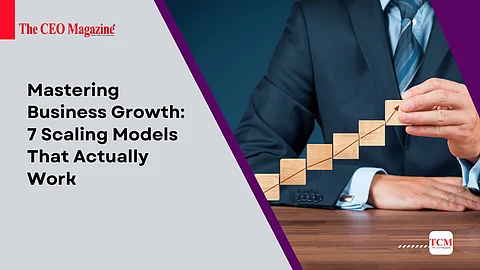
- News
- Women
- Magazine
- IndustryIndustry
- InsightsInsights
- Success Stories
- PublishPublish
- ContactContact
- Media KitMedia Kit

Mastering Business Growth
Let me ask you something:
Have you ever felt like your business has hit a ceiling?
You’ve built a solid product. You have a loyal customer base. Maybe even a team you trust.
But somehow, growth has plateaued — and scaling feels like pushing a boulder uphill.
You’re not alone. I’ve been there, and I’ve helped founders across sectors go from stagnation to strategic scale.
Because here’s the truth:
Growth is good. But scaling is strategic.
And in today’s uncertain, highly competitive market, how you scale matters more than how fast you scale.
So let me walk you through 7 business scaling models that actually work. These are battle-tested, not buzzwords.
And by the end of this guide, you’ll know exactly which model suits your vision.
Before we dive into the models, let’s clear one thing up:
Scaling is not just about growth.
It’s about growing efficiently, sustainably, and profitably — without burning out your resources.
“If growth is the engine, scaling is the fuel economy.” — Someone smart (and probably exhausted from startup chaos)
In my experience, startups often scale reactively — chasing trends, adding people, or expanding too fast — instead of scaling with clarity, consistency, and customer focus.
So let’s change that.
Let your product be your best salesperson.
If you’ve used Slack, Dropbox, or Notion — you’ve experienced Product-Led Growth.
This model revolves around building a product so intuitive, valuable, and viral that users spread it themselves.
Offer a freemium or trial model
Allow self-service onboarding
Use in-product prompts and upgrades
SaaS and digital product companies
Tech startups targeting scale without high sales overhead
Slack grew to millions of users without a traditional salesforce by focusing on product design and team-based virality.
Perfect for high-ticket, B2B, or consultative sales cycles.
Here, you rely on skilled sales teams to build relationships, close deals, and expand accounts.
Structured sales funnel (SDR → AE → CS)
Targeted outbound + inbound marketing
Account-based marketing (ABM) strategies
B2B service providers
Fintech, legaltech, martech startups
One client of mine in enterprise cybersecurity scaled ARR from ₹2 Cr to ₹15 Cr by investing in a rockstar sales team and CRM automation.
Create value by connecting two sides of the transaction.
Think Uber, Zomato, Airbnb. These platforms scaled by building trust and efficiency between buyers and sellers.
Balance supply and demand with user incentives
Invest in trust, UI/UX, and secure payments
Charge via commissions or listing fees
Aggregators, logistics, services, events
Chicken-and-egg problem — which side do you onboard first?
Start hyperlocal. Nail one region before expanding. Focus on liquidity over vanity metrics.
Leverage other people’s capital and effort to scale.
If your business model is replicable, franchising lets you grow geographically without owning every outlet.
Create standardized brand, ops, training
Charge franchise/license fees + royalties
Provide backend support and marketing
F&B brands, retail chains, education companies
India’s WOW! Momo used a franchise model to expand to 400+ locations with consistent quality control.
Build a value ecosystem, not just a product.
Apple didn’t just sell iPhones. It built an ecosystem of apps, accessories, services.
This model encourages multiple touchpoints per user.
Cross-sell complementary products/services
Create platforms for developers/partners
Foster user communities and loyalty programs
D2C brands, hardware, tech platforms
A startup I advised in smart-home tech bundled lighting, locks, and voice-control into one ecosystem — doubling LTV per customer.
Scale through affiliates, resellers, or strategic partners.
Instead of doing everything in-house, you tap into existing distribution networks or influence channels.
Identify high-value partners (agencies, influencers, distributors)
Offer incentives, co-branded marketing
Monitor partner performance actively
Healthtech, edtech, SaaS, and D2C companies
An Indian HR SaaS company used consulting firms as channel partners — scaling from 50 to 800 clients in 18 months.
Win by building belonging before you sell.
Your most passionate users can become your biggest growth engine.
Build authentic communities (forums, Discord, events)
Empower superfans and ambassadors
Use feedback loops to co-create and evolve
Creator economy, edtech, Web3, and consumer startups
“People don’t buy products — they join movements.”
What movement is your brand enabling?
There’s no one-size-fits-all model.
Here’s a quick decision table:
Business Type
Best Scaling Model
SaaS (low-touch)
Product-Led Growth
Enterprise B2B
Sales-Led Growth
Aggregator/App
Marketplace Model
Retail/Service Chain
Franchise Model
Consumer Tech
Ecosystem Model
Early-stage B2B
Partner-Led Growth
Passion/Niche Brand
Community-Led Growth
Still unsure? Ask yourself:
What’s my customer acquisition cost (CAC) vs lifetime value (LTV)?
Do I need speed or depth right now?
What’s scalable without compromising quality or cash flow?
Top Growth Metrics Every Startup Should Track
Scaling Sustainably: Lessons from India’s Fastest-Growing Unicorns
How to Raise Funding Without Losing Focus
Growth is exciting. Scaling is strategic.
And mastering business growth means picking the right model for your stage, team, and market reality.
So whether you're a solo founder or leading a 100-member team, let me leave you with this:
"If you want to go fast, go alone. If you want to go far, choose the right model — and go with focus."
Now it’s your turn.
Which model are you ready to implement?
DM me your biggest scaling challenge — let’s solve it together.
Follow us on Google News
